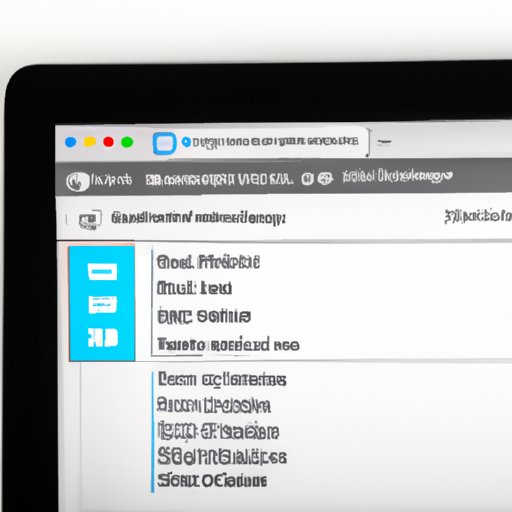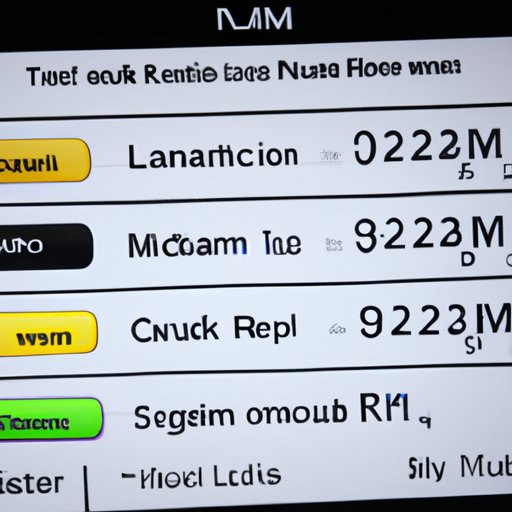Introduction
Mac users often need to check their RAM (Random Access Memory) usage in order to ensure their device is running smoothly. RAM is responsible for storing data that is currently being used by applications and the operating system, and it’s important to monitor how much RAM is being used. In this article, we will explore how to check RAM usage on Mac, looking at different methods such as using Activity Monitor, Terminal commands, System Information, Spotlight search and third-party apps.

Use Activity Monitor to Check RAM Usage on Mac
Activity Monitor is a built-in utility in macOS that allows you to view the real-time performance of your Mac. It can be used to monitor CPU, memory, disk, energy and network activity on your device. To open Activity Monitor, go to the Applications folder or type “Activity Monitor” into Spotlight search.
Once you have opened Activity Monitor, you can view your RAM usage by clicking on the Memory tab. Here, you will be able to see the total amount of RAM installed on your Mac, as well as the amount of RAM that is being used and the amount of RAM that is available. You can also sort processes by memory usage to see which applications are using the most RAM.
Utilize Terminal Commands to Measure RAM Usage on Mac
The Terminal app is a powerful tool that can be used to execute commands and run scripts on your Mac. It can also be used to check RAM usage on Mac. To open Terminal, go to the Utilities folder or type “Terminal” into Spotlight search.
Once you have opened Terminal, you can use several commands to view your RAM usage. The “top” command shows the current RAM usage on your Mac, while the “ps” command will list all the processes running on your Mac and how much RAM each one is using. Additionally, the “vm_stat” command will show the overall RAM usage on your Mac.

Use System Information to Gauge RAM Usage on Mac
System Information is another built-in utility in macOS that allows you to view detailed information about your Mac. It can be used to monitor hardware components such as RAM, CPU, storage and more. To open System Information, go to the Applications folder or type “System Information” into Spotlight search.
Once you have opened System Information, you can view your RAM usage by clicking on the Memory tab. Here, you will be able to see the total amount of RAM installed on your Mac, as well as the amount of RAM that is being used and the amount of RAM that is available. Additionally, you can view information about each memory slot, including the module size and speed.

Check Memory Usage with Spotlight Search
Spotlight search is an easy way to quickly find files and applications on your Mac. It can also be used to check RAM usage on Mac. To open Spotlight, press Command + Spacebar or click on the magnifying glass icon in the top right corner of your screen.
Once you have opened Spotlight, type “Memory” into the search bar. This will bring up a graph showing your RAM usage, as well as the amount of RAM that is being used and the amount of RAM that is available. Additionally, you can click on the Memory tab to view more detailed information about your RAM usage.
Examine RAM Usage with Third-Party Apps
There are also several third-party apps available that can be used to check RAM usage on Mac. These apps offer more detailed information than the built-in utilities, as well as additional features such as notifications when your RAM usage reaches certain levels. Some popular third-party apps include iStat Menus, Memory Cleaner, Memory Optimizer and Memory Cleaner Pro.
To use a third-party app to check RAM usage on Mac, simply download and install the app on your device. Once the app is installed, open it and follow the instructions provided. Most third-party apps will show your RAM usage in the form of a graph, as well as the amount of RAM that is being used and the amount of RAM that is available.
View Memory Status in the Menu Bar
You can also view your RAM usage in the menu bar. To do this, open System Preferences and click on the “Memory” tab. Here, you can select the “Show Memory Status in Menu Bar” option. This will add a small graph to the menu bar that displays your RAM usage, as well as the amount of RAM that is being used and the amount of RAM that is available.
Conclusion
In this article, we explored how to check RAM usage on Mac, looking at different methods such as using Activity Monitor, Terminal commands, System Information, Spotlight search and third-party apps. We hope this article has been helpful in understanding how to monitor RAM usage on Mac and ensuring your device is running smoothly.
For further reading, check out our articles on how to free up RAM on Mac and how to optimize RAM usage on Mac.
(Note: Is this article not meeting your expectations? Do you have knowledge or insights to share? Unlock new opportunities and expand your reach by joining our authors team. Click Registration to join us and share your expertise with our readers.)
